Striped Skunk, Hooded Skunk, & Hognosed Skunk
Main sources: Nowak, Ronald, 1991, Walker's Mammals of the world, Fifth Edition (two vols.), Baltimore: Johns Hopkins University Press; Hoffmeister, D. F., 1986, Mammals of Arizona, Tucson: University of Arizona Press; Burt, W. & R. Grossenheider, eds., 1976, A Field Guide to the Mammals, Peterson Field Guides: Houghton Mifflin; For an overview of the distinctive characteristics of skunks, look under "Mephitidae" in Mammals.
Striped Skunk (Mephitis mephitis)
The Striped Skunk is generally the most familiar skunk to U.S. citizens because it is the most common and widespread skunk in North America, found in all states of the Union and northward into Canada. Larger than Spotted Skunks, at 6-14 lbs in weight, it has a black body, narrow white line up the mid-forehead, and a broad white area on the nape, dividing (usually) into a V at the shoulders (Burt & Grossheider, cited above, p. 65). In our photographic record, we find only one relatively unambiguous image fitting this description, taken in July of 1998 at the Lower Cottonwood Seep off Hot Springs Canyon:
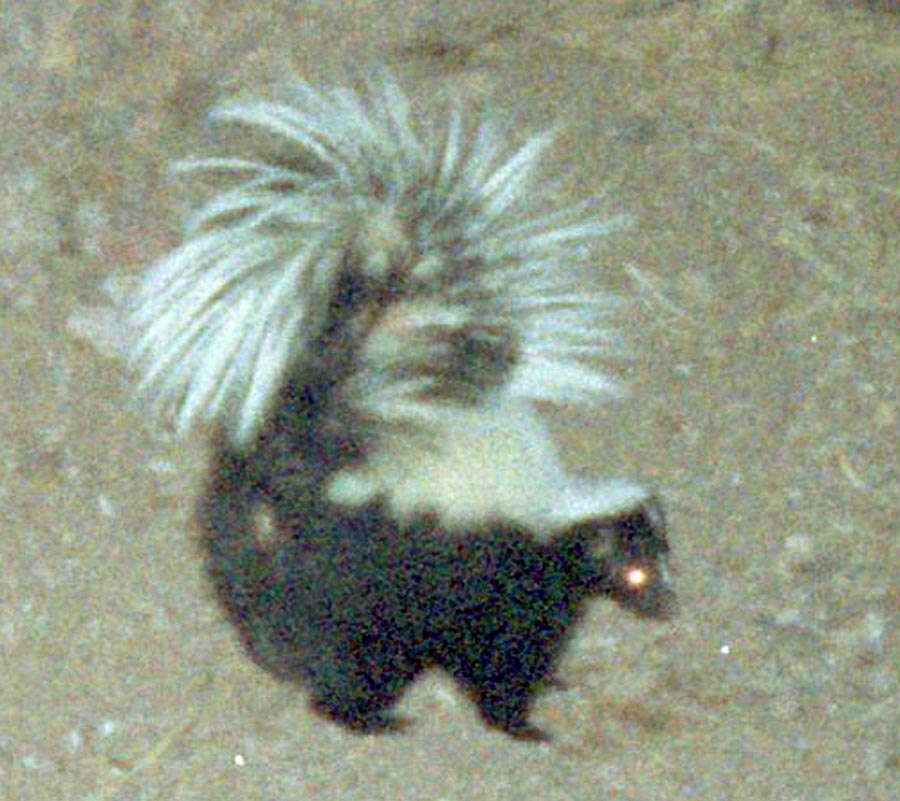
This image, taken at a considerable distance with this old film camera (infrared), nevertheless shows the black body and the vertical white forehead stripe fairly clearly, so we may (initially anyway) infer that it is indeed a Striped Skunk.
These relatively large-bodied skunks are found in a wide variety of habitats (woods, grasslands, and deserts). They are mainly nocturnal (but are often seen in early morning or late evening), spending days in burrows (or any dry, sheltered spot), and are generally solitary. They eat a variety of rodents and insects as well as vegetation -- are very opportunistic in their feeding. They are active all year round in our area.
Hooded Skunk (Mephitis macroura)
After discarding our infra-red film camera operations of the late 1990s (far too many useless results, disovered after too much delay in getting film developed), yet more recently wanting to document our wildlife in greater detail, we obtained in late 2008 an HCO Scout Guard IR Camera 5MP Series SG550, a good-quality digital infrared camera that takes images both in color (by daylight) and black-and-white (at night). Using this camera (as well as an older one, also digital but showing color at night with a flash attachment), we have obtained many more images, gathering them from both lower Hot Springs Canyon and along the San Pedro River near Cascabel. Nearly all the skunks revealed so far in these images appear to be Hooded Skunks, though Burt & Grossheider observe that "This skunk barely enters s. U.S." (ibid.). Clearly the general distribution of this skunk is southerly (it reaches all the way to Costa Rica). A couple of the images below may however show Hognosed Skunks (whose distribution is also southerly).
According to both Walker (cited above) & Burt & Grossenheider, Hooded Skunks appear in two distinct color varieties (with intermediate transitions), which initially gave us as interpreters some difficulty, and moreover the Hognose Skunk overlaps one of these in coloration, so the populations seem complex.
The first variant is distinct from the Striped Skunk in that it is nearly all black (from head-tip to tail-tip), it has two white side-stripes, and its tail is very long:
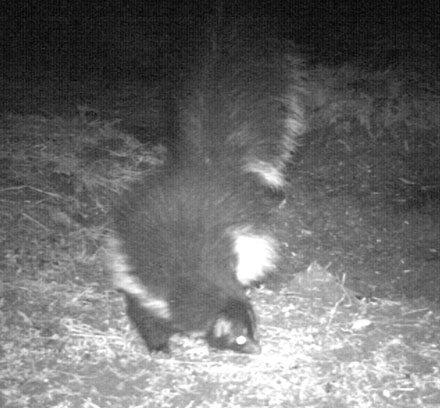 .
.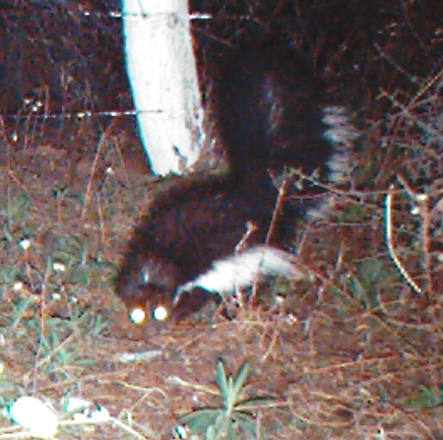
The image at left above was captured in lower Hot Springs Canyon in late December 2008; the one at right along the San Pedro in January 2009.
The second variant shows a back that is chiefly white, including its very long tail:
 .
.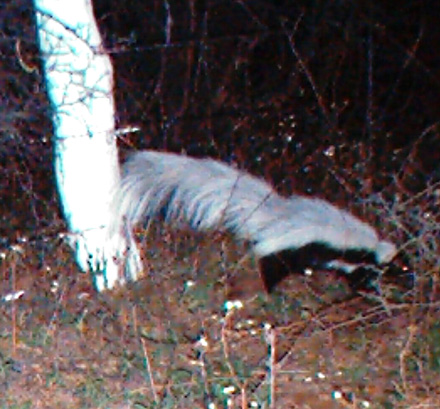
This skunk, photographed along the San Pedro River in January 2007, clearly shows this pattern, as does this one from lower Hot Springs Canyon photographed in lower Hot Springs Canyon in late December 2008:
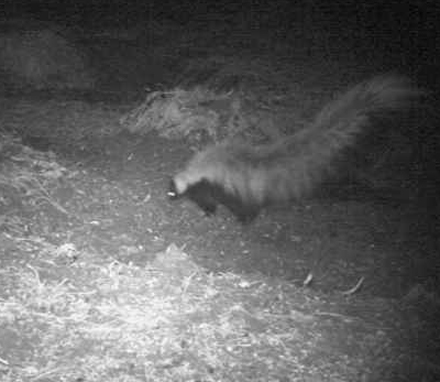
Here the length of the tail appears truly phenomenal.
We have not yet photographed the third variant of this group, the
Hognosed Skunk (Conepatus leuconotis)
Burt & Grossheider (p.68) describe this skunk as follows: the "entire back and tail are white and the lower sides and belly are black", while the animal's name is given by virtue of its "long and piglike snout that is naked for about 1 inch (25mm) on top." Its tail is shorter than that of the Hooded Skunk.
We thought the images below might fit that category, with what appears to be a more protruding (and "naked-looking"?) snout than the others, but Dr. Christine Hass tells us that hog-nosed skunks have a solid white back (while the one below has black and white mixed, which is a hooded skunk character), and it has a stripe on its face. Hog-nosed skunks do not. They also have a shorter, almost triangular shaped tail, which is almost always carried straight up.
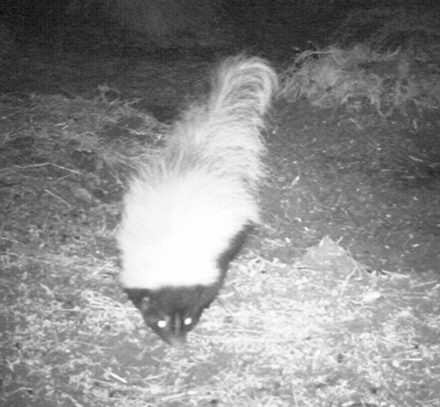 .
.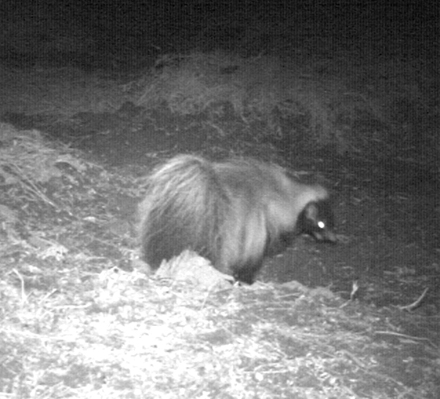
Dr. Hass recommends the following website, Audubon Research Center, "Skunks of Arizona", which provides descriptions, images, and maps of geographic distribtion for our 4 Arizona skunk species.